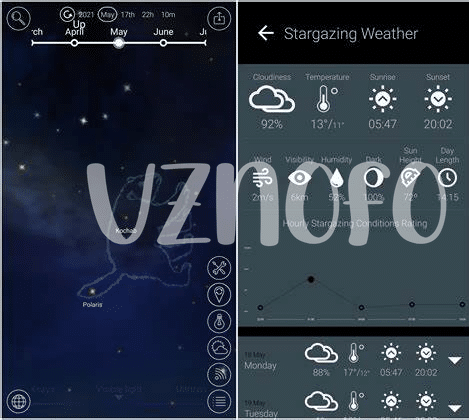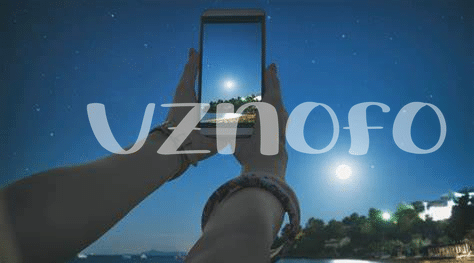- 🌟 Stargazing Simplified: Exploring the Cosmos on Android
- 🌌 Night-sky Wonders at Your Fingertips with Stellarium
- 🔭 Sky Map: Navigate the Nightscape Like a Pro
- 🛰️ Track Satellites and Stars with Satellite Ar
- 🌙 Moon Phase Calendar: Craters and Seas Revealed
- 📡 Discovering Deep Space: Distant Galaxies on Your Screen
Table of Contents
Toggle🌟 Stargazing Simplified: Exploring the Cosmos on Android

Once upon a time, gazing up at the stars meant mapping constellations with our ancestors’ stories and charting astronomical paths by hand. But now, in an age where our phones have more computing power than the machines that first sent humans to the moon, we can journey through the universe without stepping outside our homes. The Android platform is teeming with apps that turn our smartphones into digital windows to the cosmos, ideal for anyone who’s ever looked up and marveled at the night sky. These apps not only show us the celestial bodies as we’d see them if the city lights were dimmed, but they also enrich our knowledge with facts and figures, making sense of what we see. With just a swipe and a tap, we’re connecting dots in the sky, uncovering the names of stars and the shapes of constellations, learning the ebb and flow of planetary movements, and even identifying that bright, wandering light as a space station orbiting Earth. Plus, there’s a bonus for the curious minds: on-screen guides filled with stories behind the constellations, mythologies spun from cultures around the world that once upon a time, like us, looked up and wondered about their place in the grand expanse.
| Feature | Description | Benefit |
|---|---|---|
| Intuitive Interface | Easy navigation to explore the stars without complications. | Makes stargazing accessible to all, regardless of experience. |
| Augmented Reality | Overlay constellations on the real night sky using the phone’s camera. | Provides a visual guide, enhancing learning and engagement. |
| Interactive Sky Charts | Touch-responsive celestial maps that show real-time positions of stars and planets. | Allows for personal exploration, making discovery a hands-on experience. |
| Educational Content | Information on celestial objects and events at your fingertips. | Enriches the stargazing experience with knowledge and context. |
| Cultural Stories | Mythologies and historical tales behind the constellations. | Connects us to the human aspect of astronomy, blending science with culture. |
Embrace the digital age with these innovative tools, and carry the night sky in your pocket, a marvel to behold whenever the curiosity strikes or the stars beckon. 🌌🔭🌙
🌌 Night-sky Wonders at Your Fingertips with Stellarium
Imagine you’re out camping, surrounded by nature’s grandeur. You look up, and there’s an awe-inspiring tapestry of stars and celestial bodies. With Stellarium, you’ve got a fantastic way to dive into that starry realm right in the palm of your hand. This app turns your Android device into a pocket observatory, where constellations, planets, and even the most distant objects in the night sky become not only visible but also understandable. Let’s explore this further.
What’s brilliant about Stellarium is that it’s like having a knowledgeable friend by your side, pointing out the secrets of the sky with clarity and ease. You’re outside, it’s a crisp night, and after firing up Stellarium, its smooth interface presents the sky in real-time, transforming your screen into a window to the cosmos. As you move your phone around, the motion-sensing technology works seamlessly to mirror the celestial sphere as seen from your location, making it almost magical. Want to know which bright dot is Jupiter or where to find the Andromeda Galaxy? Just tap on the sky objects, and voilà—it’s all at your fingertips, enriched with mythology and scientific insights.
For those who love the moon, Stellarium serves as a guide to its craters and seas, providing a closer look at our lunar neighbor. Now, if you’re curious to capture these moments, you might wonder what is the best camera app for android 2024 top 5 apps updated?. With the right camera app, you can juxtapose the beauty of the celestial with the terrestrial; a dazzling moon over a serene lake, or the sparkle of Venus at twilight.
Stellarium is your portable answer to the night sky’s enchantment, a way to explore and learn, expanding your horizons to the universe’s splendor. 🌠🌛 Whether you’re an avid skywatcher or a casual fan, this app is a delightful companion on your stargazing journey.
🔭 Sky Map: Navigate the Nightscape Like a Pro
Imagine turning your phone into a window to the night sky, where stars and constellations align in the palm of your hand. With just a few taps, you transform your Android device into a personal guide through the stars above. 🌌 No need to be an astronomer; this app brings the universe to you. You’re outside, and as the twilight fades, you open the app, point to the sky, and suddenly, familiar patterns take shape. The Big Dipper, Orion, and maybe even a planet or two reveal themselves as you sweep your phone across the heavens.
This stargazing tool is not only for clear nights but also serves as an educational companion. 📚 On a cloudy evening, you can still embark on a cosmic journey from the comfort of your couch. Swipe through the sky, delve into constellations’ myths, and learn to spot the celestial bodies as they parade across the sky. The app becomes a bridge between you and the cosmic dance above, letting you tap into the ancient art of reading the night sky from anywhere at any time. Whether you’re a curious newbie or a seasoned sky watcher, this portable observatory shrinks the universe down to smartphone size, making the celestial navigation an experience everyone can enjoy. 🌟
🛰️ Track Satellites and Stars with Satellite Ar
Imagine having the power to track the fast-moving visitors of our skies with just your Android phone. Satellite AR is an app that lets you do just that, transforming your device into a powerful window to the sky above. Point your phone to the heavens, and this app overlays the positions of satellites in real-time over what you see through the camera. It’s like having a personal guide to the celestial ballet performed by human-made objects in orbit. From spotting the International Space Station’s graceful pass to catching sight of a distant weather satellite, you’re in for an absorbing experience. Not only for space enthusiasts but also for curious minds, it offers an easy and interactive way to learn and identify what’s soaring above us.
As you delve into the marvels of the night sky, capturing these moments can be just as important as witnessing them. With the right tools, you can turn your skywatching adventures into stunning memories. Are you wondering what is the best camera app for android 2024 top 5 apps updated? Whether you’re trying to snap a shot of the gleaming dots crossing the dark expanse or the intricate details of the moon’s surface, having a handy camera app can make all the difference. Pair your stargazing app with a top-notch camera application to capture the magic of the night sky, and you won’t just watch the stars – you’ll be bringing a piece of the cosmos right into your photo gallery, all while stepping up your photography game to stellar heights. 🌟📸🌙
🌙 Moon Phase Calendar: Craters and Seas Revealed
Imagine holding a little piece of the moon right in the palm of your hand. With the right app on your Android device, the ever-changing face of our lunar neighbor unveils its secrets to you. It’s like having a mini-moon in your pocket where you can zoom in on the craggy craters and vast seas that have beckoned humanity for centuries. As you watch the moon wax and wane through its phases, you’ll discover the rhythm of the lunar cycle and how it affects our world, from the tides of the ocean to the behavior of animals. These apps don’t just put the moonscape at your fingertips; they teach you about lunar events, eclipses, and the best times to look up and witness the moon in all its glory.
Apps that map out the moon’s surface offer more than just pretty pictures; they’re packed with information. A tap on your screen can show you where the Apollo astronauts landed or where to find the Sea of Tranquility. Want to know why the moon looks full tonight or why it’s just a sliver in the sky? The app tells you that, too. Below is a table highlighting the features of these enlightening lunar companions that make exploring the moon an interactive adventure.
| Feature | Description |
|---|---|
| 🔭 Zoomable Lunar Maps | Get up close with moon craters and maria from your screen. |
| 📅 Lunar Calendar | Track the moon phases and anticipate full or new moons. |
| 🌘 Eclipse Information | Learn when to view lunar and solar eclipses. |
| 🛰️ Apollo Landing Sites | Explore the historic sites where humans left their footprints. |
| 🌌 Night Mode | Protect your night vision while observing the moon. |
And there’s a bonus: by learning the moon’s patterns, you’re connecting with people through time who’ve used its guidance for everything from farming to navigation. Who knew that a simple app could unearth so many treasures hidden in plain sight up in the night sky?
📡 Discovering Deep Space: Distant Galaxies on Your Screen
Imagine peering far beyond our own Milky Way, to the very edges of the universe, all from the cozy corner of your home. With the latest Android sky apps, the farthest reaches of space unfold in spectacular detail on the small screen of your phone or tablet. You can dive into a sea of stars, witness the birth of galaxies through cosmic dust, and be dazzled by the swirls of otherworldly nebulae. Each starry spectacle is a chance to learn and marvel at the mysteries that dot our universe.
🌌✨ The beauty of these apps isn’t just in bringing distant galaxies into view, but also in how they make understanding the cosmos more accessible. Curious minds can navigate through constellations and identify celestial bodies with pinch-and-zoom gestures. It’s as if you’re on a personal tour guided by the universe itself. For those fascinated by what lies beyond our sky, these apps are a gateway to the wonders of space. They make the infinite cosmos not just visible, but comprehensible and incredibly engaging, all without needing a giant telescope. 🚀🌠



